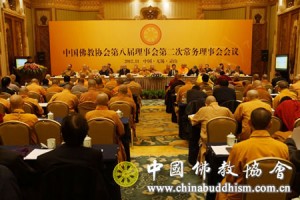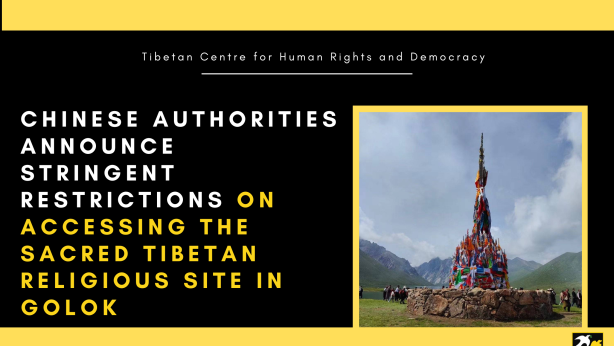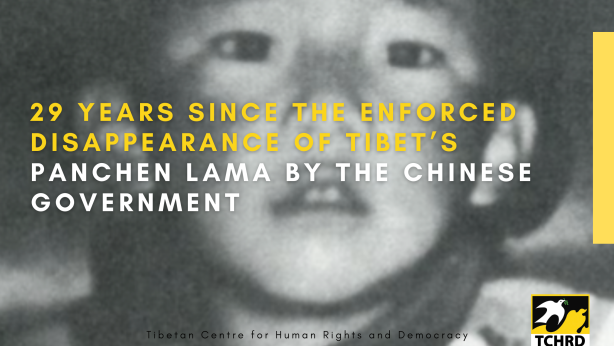China implements measures to appoint political monks in guise of spiritual teachers

In the past weeks, there has been persistent speculation on ‘experimental’ moves by the Chinese authorities to overturn some of its decades-old vilification campaign against the Tibetan spiritual leader, His Holiness the Dalai Lama. A handful of Tibetan monasteries in the Tibetan provinces of Amdo and Kham, located respectively in present-day Qinghai and Sichuan provinces, were given verbal permission to display portraits of the Dalai Lama and worship him as a religious, and not as a political figure. According to these verbal orders, monks and nuns are no longer required to denounce the Dalai Lama, which is an essential component in political education classes in Tibet’s monastic institutions. Major international media outlets heralded this as a change in China’s Tibet policy.
Only a few days later on 28 June 2013, China’s State Administration for Religious Affairs (SARA), the highest official body that regulates all recognised religions in the People’s Republic of China, denied any reversal of its long-standing policy on the Dalai Lama.
According to information received by TCHRD, some monasteries in Qinghai, particularly in Tsolho (Ch: Hainan) Tibetan Autonomous Prefecture indeed were told to worship the Dalai Lama and display his portraits. Sources also told TCHRD that the caretakers at the home monastery of an imprisoned reincarnated lama (name withheld) in Kardze (Ch: Ganzi) County had recently been told by County government officials to display the imprisoned lama’s portraits in the monastery. However, in all these cases, no written permission in the form of documents endorsing a policy change was distributed among these monasteries indicating that the authorities are unsure of how the trial measures on the Dalai Lama will play out over time. Mindful of the role of new media in spreading information quickly and widely, the authorities have carefully avoided putting their directives in writing.
Generally, authorities in Tibetan areas outside Tibet Autonomous Region (TAR) have been relatively lenient regarding the display and worship of Dalai Lama’s portrait. That changed after widespread protests occurred on the Tibetan plateau, in particular protests continued unabated in Tibetan areas in Qinghai, Sichuan and Gansu provinces. Moreover, the Fifth Tibet Work Forum convened in January 2010 in Beijing to review Tibet policy announced the adoption of a uniform policy for for TAR as well as Tibetan areas in Sichuan, Yunnan, Gansu and Qinghai provinces – an important departure from the official practice of considering ‘Tibet’ as composing only TAR. In September 2012, a public notice issued by Rebkong (Ch: Tongren) County authorities in Malho (Ch: Huangnan) Tibetan Autonomous Prefecture in Gansu openly called for a strict ban on the sale of Dalai Lama’s photos.
The continued restrictions placed on foreign journalists and other fact-finding delegations visiting Tibet make it difficult to gauge the real situation and to construct an accurate picture of changed practices and attitudes of local Chinese authorities vis-a-vis the Dalai Lama’s portraits in Tibetan areas outside TAR. The possible change in policy regarding the Dalai Lama’s portrait is the only positive change regarding religious freedom in Tibet. Over the years, religious freedom in Tibet has changed for the worse, particularly in recent years after the implementation of a systematic, widespread campaign to eliminate any signs of opposition against the party and the government. Since the end of 2011, Tibetan monastic institutions have been brought under the direct control of the Chinese government and party cadres, ending the nominal autonomy enjoyed by Tibetan Buddhist institutions for decades.
New measures to appoint politico-religious instructors
To further tighten the noose around Tibetan monasteries and nunneries, the Chinese government has implemented a new regulation that gives the government and Party organs at multiple levels the authority and power to appoint Buddhist religious instructors. The regulation called “Measures to Determine Qualification and Employment of Religious Instructors in Tibetan Buddhist Monasteries” was published on 3 December 2012 after its approval during the second session of the eighth council of Buddhist Association of China held on 25 November 2012. The new regulation has been implemented from the day of its publication.
Under this regulation, all religious instructors at Tibetan Buddhist monasteries must be legally registered to continue teaching Buddhist scriptures (Article 2). Further the regulation states that to qualify as a religious instructor, a candidate must meet mandatory credentials, including support for the leadership of the Chinese Communist Party and the socialist system, patriotism, discipline, uphold the dignity of law, safeguard the people’s interests, safeguard national unity, and uphold religious and social harmony [Article 4 (ii)].
A candidate must not engage in activities organised at the behest of private individuals or overseas outfits [Article 4 (vi)] and must obey the Monastery Management Committees. Monks and nuns as well as lay believers must accept the guidance and supervision of the local people’s government and relevant departments of Buddhist religious affairs [Article 4 (iii)].
Article 5 of the regulation requires that candidates be nominated and recommended by Monastery Management Committees. Then the candidates’ credentials will be assessed and reviewed first at the county level BAC office. This is followed by another assessment and screening at the prefecture level of BAC. Shortlisted candidates must sit for an examination administered by prefectural branch of BAC.
In an interesting exception, Buddhist teachers who are over 50 years old and have been teaching for a considerable time, may be exempted from this examination provided they satisfy all the credentials listed in article 4 [Article 4 (iii)]. This exemption is likely aimed at avoiding potential conflicts in monastic institutions following the firing of senior religious teachers. As TCHRD reported in March 2013, senior religious teachers were removed at Rongwo Monastery and Labrang Tashikyil Monastery located respectively in Qinghai and Gansu provinces.
Religious instructor candidates who pass the examination will have their credentials reviewed and assessed by the province and autonomous region level of the Buddhist Association of China (BAC), an organ of the Communist Party. BAC will then issue a certificate to endorse the qualifications of a religious instructor [Article 4 (iv)].
This regulation affects all monastic institutions in TAR and the Tibetan areas outside TAR. In the areas where there are no BAC branch offices, applications must be made to prefectural or provincial BAC branches [Article 4 (v)].
Article 10 of the regulation stipulates that religious instructs appointment can last no more than five years after which they must apply for renewed employment. Those seeking re-appointment should undergo the same process of getting clearance and approval from the relevant BAC offices and local religious affairs departments.
The duties of religious instructors are listed in the regulation. It says qualified religious instructors should assist the Monastery Management Committees in the management work of education and guidance of monks and nuns, patriotism, unity and progress, maintaining “normal order” in monasteries, promotion of religious harmony and social harmony [Article 11 (iii)]. The religious instructors are also required to promote national policies and regulations to guide the masses of believers, consciously safeguard national unification, ethnic unity and social stability, and oppose separation [Article 11 (iv)].

Chapter four of the regulation is titled “Penalties”. This chapter addresses the punishments for religious instructors “who violate the employment agreement or do not perform their duties”. Depending on the severity of the case punishments may include verbal exhortation [or political education classes], suspension of employment, dismissal, and withdrawal of all rights and privileges of a religious instructor (Article 15).
Following are some of the activities that may merit immediate dismissal or suspension from employment as enumerated in article 15:
– Failure to follow orders of monastery management committees;
– Acting on the instigation of overseas outfits and private individuals;
– Spreading separatist ideas and inciting the monks and nuns, as well as lay believers promoting illegal criminal behavior;
– Engaging in activities to destroy ethnic unity and social stability; and for splitting the Chinese motherland.
Through attrition, this policy will ultimately decrease the number of truly qualified Buddhist teachers and diminishes the transmission of Tibetan Buddhist culture, and language throughout Tibet. In the past China has defended its persecution of Tibetan Buddhism by saying that it is provided for by Chinese law. However, it is little consolation that the government is exercising control over control religious practices and teachings by passing and implementing laws.
A host of regulations to restrict religious freedom are now being implemented in Tibet at all levels of government. These regulations subvert the Chinese Constitution’s theoretical guarantee of ‘freedom of religious belief’. What little freedom in words given at the highest document of law is taken away in practice by multiple local levels by tight government and party control.
The restrictions of freedom of religion in China date back to the founding of the BAC. The BAC was founded in 1953 to place Buddhism under the leadership of the Communist Party. The BAC strictly limits Buddhist activity and controls the monastic institutions. The BAC is an organ of the State Administration for Religious Affairs, which regulates all recognized religions in PRC. It exercises its jurisdiction over all Buddhists in the PRC by working closely with the United Front Work Department.
In recent years the BAC has stepped up its efforts to promote its form of Buddhism while stifling and demonizing other perspectives. In 2009 at the Second World Buddhist Forum in the eastern Chinese city of Wuxi, the BAC’s vice president, Ming Sheng, said the association would have considered extending invitation to His Holiness the Dalai Lama had the Tibetan spiritual leader abandoned his ‘separatist activities’.
Harmonious Model Monasteries, Advanced law-abiding monks and nuns
Over a week ago, on 29 June 2013, during the second ceremony to award ‘harmonious model monasteries’ and ‘advanced law-abiding monks and nuns’ in Lhasa, the Lhasa City Communist Party chief Qi Zhala, thanked the gathering of ‘advanced, law-abiding monks and nuns,’ ‘advanced Monastery Management Committees’, and ‘outstanding cadres stationed in monasteries’ for their continued support to the implementation of TAR stability maintenance policy. Qi encouraged the attendees to “make persistent efforts to contribute to future work in stability maintenance and create a new result out of a new system.”
In April 2012, in his address during the first award ceremony for ‘harmonious model’ monasteries and nunneries and ‘advanced law-abiding monks and nuns’, TAR Party secretary Chen Quanguo said that monks and nuns should “effectively recognize the politics of the Dalai Clique’s reactionary religious hypocrisy, deceptive means” and separate themselves from separatist activities by “draw[ing] a line with the Dalai Clique” and not participating in separatist activities to “disrupt social order.”
‘No free meal charity’
The government’s claims of regulating religion in the name of providing social services to monks and nuns is difficult to believe given its political motivation. On 12 November 2011 at a high-level meeting in Lhasa, the TAR Party chief Chen Quanguo introduced plans to provide “universal social welfare” to monks and nuns in return for political allegiance to the Chinese Communist Party and the Chinese state, before issuing a warning to the Dalai Lama not to interfere with the reincarnation of “living Buddhas”. Chen also proposed to “establish a model of temples in Tibet with patriotic, law-abiding monks being praised and honored, and with more efforts being made by monks in their religious and legal studies.”
The establishment of harmonious monasteries and cultivating law-abiding monks and nuns is part of a larger proposal to introduce highly restrictive and invasive control over monastic institutions in Tibet. Indeed, it is impossible for critics of Chinese policy to receive any state benefits. Under this uneasy bargain, the government promises “universal social welfare” in return for ‘maintaining social stability’. This policy is the monastic equivalent of “Solidify the Foundations, Benefit the Masses” (Ch: qiangji huimin).
A ‘special’ group of population will not qualify for “universal social welfare’, such as former political prisoners, monks and nuns who participated in 2008 protests. This biased approach in providing basic welfare services was articulated by Xu Guangzhi, a professor with Tibet University in a November 2011 interview with the Global Times, a sister publication of the party’s flagship newspaper, People’s Daily. Xu said the social welfare program “should not be a free meal charity mission” and that the “monks covered by the welfare mechanism should at least protect the unity of the country and local stability.” Xu said, “separatists should not be included in the program.”
Since late 2011, the Monastery Management Committee – unelected “monastic government work-unit” (Ch: zhusi danwei) – has been established in every monastery, with up to 30 lay officials stationed in each monastery, depending on the size of the institution. The establishment of MMCs has taken away nominal autonomy enjoyed by the erstwhile “Democratic Management Committee,” which although controlled by government and party officials, comprised of monks elected by their own community. By February 2012, the Chinese government had established Monastery Management Committees in 1,787 monasteries in TAR.
The new regulations controlling who may be a religious instructor at Buddhist monasteries in Tibet is a continuation of the Chinese policy of curtailing freedom of religion in Tibet. The new regulations are a dramatic escalation because they are designed to undermine the ability of monasteries to pass on to younger generations thousands of years of Tibetan Buddhist teachings that have not been politicised and manipulated by the Chinese government. China’s verbal commitments to permit His Holiness the Dalai Lama’s portraits to be displayed and worshipped is a step forward but was preceded by countless steps backward. China must not only honor its verbal commitments but also uphold the principle of freedom of religion enshrined in their constitution.
Endnotes:
- Full text of the regulation available in Chinese on the website of SARA. http://www.sara.gov.cn/zcfg/qgxzjttxgjgzd/18114.htm [TCHRD referred to Tibetan language version of the regulation to write this report.]
- China denies lifting ban on Dalai Lama worship. http://www.bbc.co.uk/news/world-asia-china-23094994
- A public notice from Amdo banning photos of Dalai Lama. http://highpeakspureearth.com/2012/a-public-notice-from-amdo-banning-photos-of-the-dalai-lama/
- Pressure mounts on Labrang Monastery after expulsion order. https://tchrd.org/2013/03/pressure-mounts-on-labrang-monastery-after-expulsion-order/
- Dalai Lama not invited to World Buddhist Forum in eastern Chinese city. http://news.xinhuanet.com/english/2009-03/27/content_11082595.htm
- Lhasa City first half of 2013 temple-cum-patriotic law-abiding harmony exemplary awards ceremony held. http://www.chinatibetnews.com/xizang/2013-06/30/content_1241887.htm
- TAR Authorities issue the first awards for ‘Harmonious Model Monasteries’ and ‘Law-abiding Monks and Nuns’. https://tchrd.org/2012/04/tar-authorities-issue-the-first-awards-for-harmonious-model-monasteries-and-law-abiding-monks-and-nuns/
- Tibet monks to receive universal benefits. http://www.globaltimes.cn/NEWS/tabid/99/ID/683726/Tibet-monks-to-receive-universal-benefits.aspx
- China: ‘Benefit the Masses’ Campaign Surveilling Tibetans. http://www.hrw.org/news/2013/06/18/china-benefit-masses-campaign-surveilling-tibetans
- Tibetan monks to receive welfare benefits from China. http://www.globalpost.com/dispatch/news/regions/asia-pacific/china/111114/tibetan-monks-receive-welfare-benefits-china
- China: Tibetan Monasteries Placed Under Direct Rule. http://www.hrw.org/news/2012/03/16/china-tibetan-monasteries-placed-under-direct-rule


